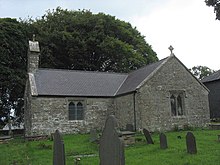St Gallgo's Church, Llanallgo
| St Gallgo's Church | |
|---|---|

The south side of the church
|
|
|
Location in Anglesey
|
|
| Coordinates: 53°20′28″N 4°15′09″W / 53.341150°N 4.252410°W | |
| OS grid reference | SH 501 850 |
| Location | Llanallgo, Anglesey |
| Country | Wales, United Kingdom |
| Denomination | Church in Wales |
| Website | Church website |
| History | |
| Founded | Early 6th century or 605 (sources disagree) |
| Dedication | St Gallgo |
| Architecture | |
| Status | Church |
| Functional status | Active |
| Heritage designation | Grade II |
| Designated | 12 May 1970 |
| Style | Perpendicular architecture |
| Specifications | |
| Length | 24 ft (7.3 m) (nave) |
| Width | 12 ft (3.7 m) (nave and chancel) |
| Materials | Rubble masonry |
| Administration | |
| Parish | Llaneugrad and Llanallgo with Penrhosllugwy with Llanfihangel Tre'r Beirdd |
| Deanery | Twrcelyn |
| Archdeaconry | Bangor |
| Diocese | Diocese of Bangor |
| Province | Province of Wales |
| Clergy | |
| Rector | Vacant |
St Gallgo's Church is a small church near the village of Llanallgo, on the east coast of Anglesey, north Wales. The chancel and transepts, which are the oldest features of the present building, date from the late 15th century, but there has been a church on the site since the 6th or early 7th century, making it one of the oldest Christian sites in Anglesey. Some restoration and enlargement took place during the 19th century.
The church is associated with the 1859 wreck of the Royal Charter off Anglesey; it was used as a temporary mortuary, and 140 of the victims are buried in the churchyard. Charles Dickens, who wrote about the loss of the ship, noted the care taken by the rector, Stephen Roose Hughes, for the victims and their families. Hughes died a few years later following the strain of the events and is also buried in the churchyard.
The church is still used for worship by the Church in Wales, as one of four churches in a combined parish. There is a regular pattern of services in English and in Welsh. St Gallgo's is a Grade II listed building, a national designation given to "buildings of special interest, which warrant every effort being made to preserve them", as a "rural church with strong Perpendicular character", retaining some features from the late 15th century. The church contains a late 13th-century bell, with an impression of a coin of King Edward I, some memorials from the 17th to 19th centuries, and some church furniture from the early 20th century in an Arts and Craft style.
St Gallgo's Church stands to the southwest of the village of Llanallgo, near the eastern coast of Anglesey, north Wales. It is about 6 miles (9.7 km) from Llangefni, the county town. According to the 19th-century writer Samuel Lewis, St Gallgo established the first church here in the early 7th century; Angharad Llwyd, a 19th-century historian of Anglesey, gives the foundation year as 605. Another writer, Geraint Jones, puts it earlier, and says in his 2006 guide to the churches of Anglesey that Gallgo established the church in the early 6th century; Jones says that it is "one of the oldest Christian sites in Anglesey." Gallgo was one of the sons of St Caw, a king from northern Britain, and a brother of St Gildas and St Eugrad (the latter establishing the nearby church of St Eugrad's in about 605 as well. Llwyd also recorded that there was a well near the church named after Gallgo, and said that "miraculous cures" had been ascribed to the waters, which were "strongly impregnated with sulphate of lime".
...
Wikipedia

